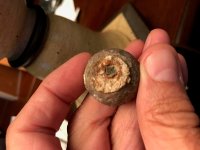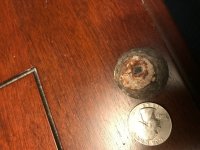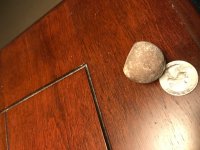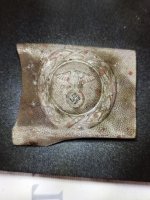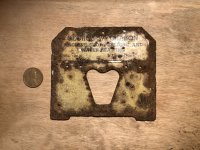bergie
Bronze Member
- Aug 2, 2004
- 1,815
- 1,147
Please see description below of the Spanish Fort at St. Augustine Florida (a great place to visit if you haven't been). Directly across from the fort - off the National Monument property about 100 yards away - is some refurbishment of condos/land in a relatively small area. I was given permission and thought I'd find more, but did find what appears to be a large piece of shot (probably lead, not sure). Any ID appreciated. Not sure what the discolored item in the middle is, but the other side is flat as if it hit something or was hit by something, but doesn't have this discolored item as does the opposite side. So, two sides across from each other are flat and the rest of it is round. I already talked to one of the Fort park rangers about this item and plan to bring it in. Would be good for them to have it if there's a connection.
The Castillo de San Marcos is the oldest masonry fort in the continental United States. Located on the western shore of Matanzas Bay in the city of St. Augustine, Florida, the fort was designed by the Spanish engineer Ignacio Daza.[SUP][1][/SUP][SUP][2][/SUP] Construction began in 1672,[SUP][3][/SUP] 107 years after the city's founding by Spanish Admiral and conquistador Pedro Menéndez de Avilés, when Florida was part of the Spanish Empire. The fort's construction was ordered by Governor Francisco de la Guerra y de la Vega after the destructive raid by the English privateer Robert Searles in 1668.[SUP][4][/SUP][SUP][5][/SUP] Work proceeded under the administration of Guerra's successor, Manuel de Cendoya in 1671,[SUP][6][/SUP] and the first coquina stones were laid in 1672.[SUP][7][/SUP] The construction of the core of the current fortress was completed in 1695, though it would undergo many alterations and renovations over the centuries.When Britain gained control of Florida in 1763 pursuant to the Treaty of Paris, St. Augustine became the capital of British East Florida, and the fort was renamed Fort St. Mark[SUP][8][/SUP] until the Peace of Paris (1783) when Florida was transferred back to Spain and the fort's original name restored. In 1819, Spain signed the Adams–Onís Treaty which ceded Florida to the United States in 1821; consequently the fort was designated a United States Army base and renamed Fort Marion, in honor of American Revolutionary War hero Francis Marion. The fort was declared a National Monument in 1924,
Attachments
Upvote
8


